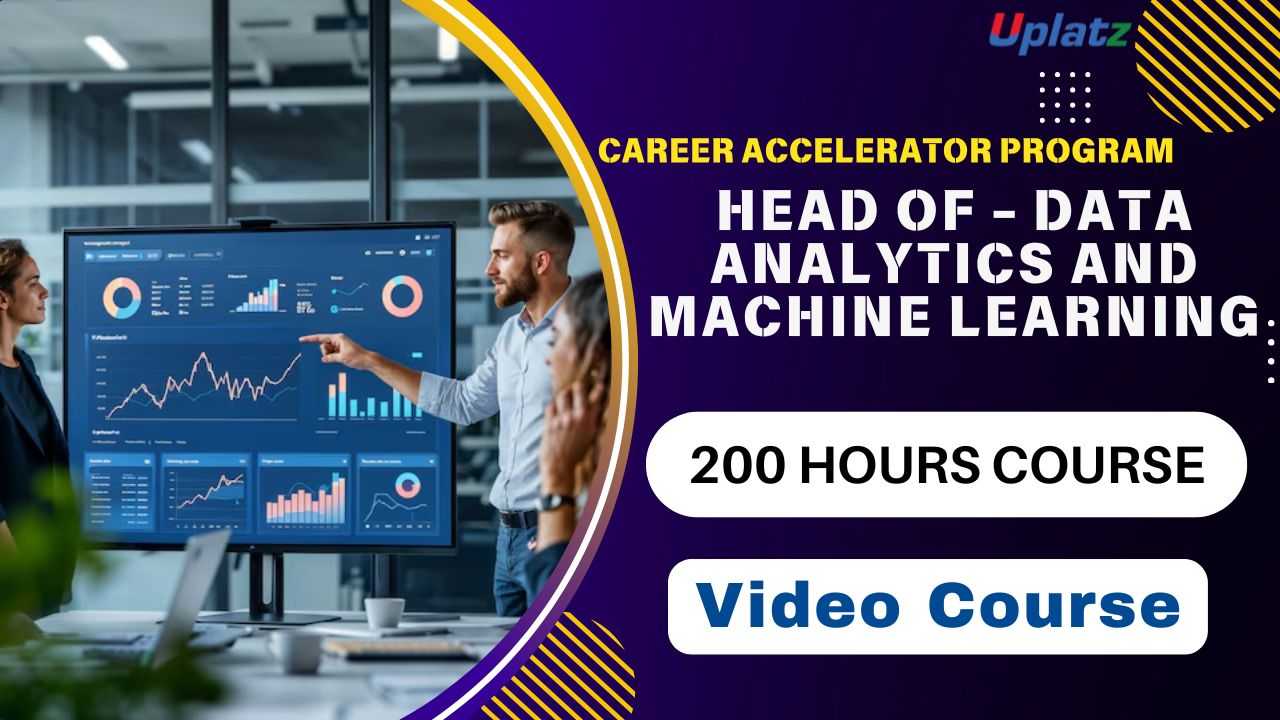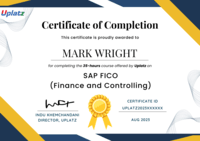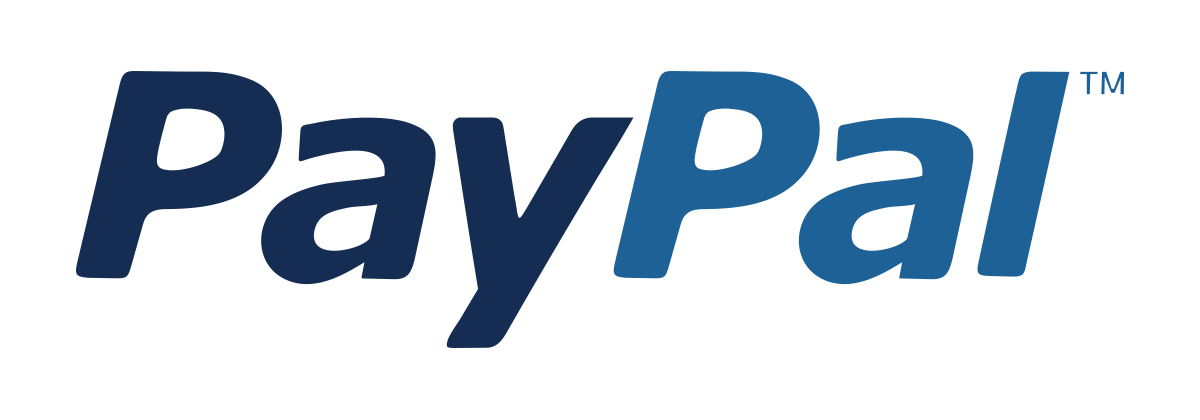Premium Career Track - AI & Machine Learning Strategist
Lead enterprise AI initiatives by aligning machine learning with business value, ethics, governance, and transformation.Preview Premium Career Track - AI & Machine Learning Strategist course
Price Match Guarantee Full Lifetime Access Access on any Device Technical Support Secure Checkout Course Completion Certificate 94% Started a new career
BUY THIS COURSE (GBP 199)
94% Started a new career
BUY THIS COURSE (GBP 199)
-
 87% Got a pay increase and promotion
87% Got a pay increase and promotion
Students also bought -
-

- Premium Career Track - Chief Data and Analytics Officer (CDAO)
- 700 Hours
- GBP 39
- 1642 Learners
-

- Career Accelerator - Head of Data, Analytics, and Machine Learning
- 200 Hours
- GBP 32
- 650 Learners
-

- Machine Learning (basic to advanced)
- 65 Hours
- GBP 12
- 4543 Learners

-
Start with Strategy: Begin by grasping the business-first foundation before diving into technical and operational topics.
-
Use Strategic Toolkits: Each module provides downloadable templates (e.g., use case matrices, ROI calculators, risk checklists).
-
Engage with Case Studies: Real examples from healthcare, fintech, retail, and manufacturing help contextualize decision-making.
-
Bridge Theory and Practice: Apply what you learn to your own organizational or consulting environment.
-
Take Notes and Reflect: This is an executive track—your insights and critical thinking will shape how you apply AI in your context.
Course/Topic 1 - Course access through Google Drive
-
Google Drive
-
Google Drive
Course/Topic 2 - Deep Learning Foundation - all lectures
-
In this session we will learn about the introduction to Deep Learning. This video talks about Deep Learning as a series introduction and what is a neural network. Furthermore, we will talk about the 3 reasons to go deep and your choice of Deep net.
-
In this video tutorial we will discuss about the neural networks and the 3 reasons to go Deep. Further we will also learn about the use of GPU in artificial intelligence and your choice of deep net.
-
In this session we will learn about the deep learning models basics. After this video you will be able to understand the concept of restricted Boltzmann machines and deep belief network. Furthermore, you will learn about the convolution neural network and recurrent neural network.
-
In this video course further topics of Deep learning models. After this video you will be able to understand the convolution neural network and its characteristics in detail.
-
In this video course further topics of Deep learning models. After this video you will be able to understand the recurrent neural network and its characteristics.
-
In this session the tutor talks about the basic Additional Deep Learning Models. In this video you will learn about Auto encoders, Recursive neural tensor network and generative adversarial networks
-
This session is in continuation to the previous session. In this video we will learn about the Recursive Neural Tensor Network in detail and hierarchical structure of data.
-
In this Additional Deep Learning Models tutorial, we will proceed with the Generative Adversarial Networks (GAN) and its uses.
-
In this video the tutor explains the Platforms and Libraries of Deep Learning. We will start with what is a deep net platform, H2O.ai and Dato Graph Lab. Further we will see what is a Deep Learning Library and Theano and Caffe. We will also cover a bit of Keras and TensorFlow.
-
This tutorial will cover the further part of DatoGraph Lab and its history. Further we wil see the benefits and uses of DatoGraph Lab.
-
This tutorial will cover the further part of DatoGraph Lab and its history.
-
In this video we will cover the further topics of Deep Learning platform and Libraries such as what is a Deep Learning Library? when and how to use Theano and Caffe as Deep Learning Library.
-
In previous video we have leant about Theano and Caffe Deep Learning Library. In this video we will learn about the TensorFlow (free and open source library) as a Deep Learning Library and building Deep Learning Models.
-
In this video we will learn about the last type of Library i.e. Keras. Keras is an open source neural network library and runs on top of Theano or TensorFlow. We will further see the advantages of Keras in Deep Learning.
Course/Topic 3 - Generative AI Specialization - all lectures
-
Lecture 1 - Introduction to Generative AI - part 1
-
Lecture 2 - Introduction to Generative AI - part 2
-
Lecture 3 - Introduction to Generative AI - part 3
-
Lecture 4 - Introduction to Large Language Models (LLMs) - part 1
-
Lecture 5 - Introduction to Large Language Models (LLMs) - part 2
-
Lecture 6 - Prompt Engineering Basics - part 1
-
Lecture 7 - Prompt Engineering Basics - part 2
-
Lecture 8 - Responsible AI
-
Lecture 9 - Generative AI - Impact - Considerations - Ethical Issues
Course/Topic 4 - Leadership and Management - all lectures
-
In this lecture session we learn about honesty and integrity in leadership and management and also talk about some basic terms of leadership and management.
-
In this lecture session we learn about how confidence is a must in leadership and management and also talk about the importance of confidence in leadership and management.
-
In this tutorial we learn about A soft skill is a personal attribute that supports situational awareness and enhances an individual's ability to get a job done. The term soft skills is often used as a synonym for people skills or emotional intelligence.
-
In this lecture session we learn about Soft skills, also called people skills, are the mix of social and interpersonal skills, character traits, and professional attitudes that all jobs require. Teamwork, patience, time management, communication, are just a few examples.
-
In this lecture session we learn that Communication in teams is more than just efficient work. It allows everyone on the team to be educated on any topic that may affect their work. Moreover, it develops trust, builds camaraderie among the team members, boosts morale, and helps employees stay engaged in the workplace.
-
In this lecture session we learn about Effective communication can help to foster a good working relationship between you and your staff, which can in turn improve morale and efficiency.
-
In this lecture session we learn about what commitment Concentration – leadership commitment involves making a personal decision to support the change no matter what. It is incongruous to ask for change in others while failing to exhibit the same level of commitment. Concentration requires maintaining focus throughout the change not just at the beginning.
-
In this lecture session we learn about Market leadership is the position of a company with the largest market share or highest profitability margin in a given market for goods and services. Market share may be measured by either the volume of goods sold or the value of those goods.
-
In this lecture session we learn that Motivational leadership is defined by positivity and vision. Motivational leaders make decisions, set clear goals and provide their teams with the empowerment and tools to achieve success. Motivational leaders evoke and see the best in their employees, inspiring them to work toward a common goal.
-
In this lecture session we learn about A primary task of leadership is to direct attention. To do so, leaders must learn to focus their own attention. When we speak about being focused, we commonly mean thinking about one thing while filtering out distractions.
-
In this tutorial we learn about Marketing analytics helps collect and strengthen data from across all marketing channels. This information is key to improving marketing efforts and driving them forward to achieve business goals.
-
In this lecture session we learn about Marketing automation is the integration of data and processes from other sales and marketing channels into an organized central platform. A comprehensive marketing automation hub complements and organizes the customer journey. It integrates all of a business's channels and outreach within the customer database.
-
In this tutorial we learn about Growth hacking (also known as 'growth marketing') is the use of resource-light and cost-effective digital marketing tactics to help grow and retain an active user base, sell products and gain exposure.
-
In this tutorial we learn about Growth Hacking is a new field focusing solely on growth, based on a data-driven, experiment-based process. A growth hacker explores new growth opportunities systematically in any part of the customer journey, from awareness through marketing to brand ambassadors by optimizing the product.
-
In this lecture session we learn about Product marketing is the process of bringing a product to market. This includes deciding the product's positioning and messaging, launching the product, and ensuring salespeople and customers understand it. Product marketing aims to drive the demand and usage of the product.
-
In this lecture session we learn about the marketing, sales, product, and customer success teams are no longer siloed. They are interwoven in a cohesive experience with the product at the center, and the customer at the center of the product.
-
In this tutorial we learn about how Product marketers know the message and story to convey, who to convey it to, and at what time it needs conveying- but marketing is responsible for turning that knowledge into blog posts, ad copy, and press releases.
-
In this lecture session we learn about PR involves communicating with your market to raise awareness of your business, build and manage your business's reputation and cultivate relationships with consumers. While marketing focuses on promoting actual products and services, public relations focuses on promoting awareness, attitudes and behavior change.
-
In this lecture session we learn about building relationships with the public in order to create a positive public image for a company or organization. It also has different disciplines, such as corporate communications, internal communications, marketing communications, crisis communications.
-
In this lecture session we learn about Public relations helps build an online presence across multiple platforms – social media, earned media, paid media and more. Public relations is important because it involves storytelling. Advertising and marketing can only go so far, and can become bothersome at times, turning consumers away from the product.
-
In this lecture session we learn about Both advertising and PR help build brands and communicate with target audiences. The most basic difference between them is that advertising space is paid while public relations results are earned through providing the media with information in the form of press releases and pitches
-
Create a holistic AI and ML strategy aligned with business objectives.
-
Identify and prioritize impactful, feasible AI use cases.
-
Assess AI readiness and build a roadmap for enterprise adoption.
-
Develop AI governance and ethics frameworks tailored to organizational goals.
-
Translate complex ML problems into business value propositions.
-
Manage cross-functional AI teams and vendor partnerships.
-
Implement MLOps strategies for scalable model deployment.
-
Design performance metrics and KPIs to track AI ROI and impact.
-
Oversee responsible AI initiatives and regulatory compliance (GDPR, AI Act, etc.).
-
Lead digital transformation initiatives powered by data and AI.
– Defining AI and ML in Business Context
– Evolution from Data Analytics to AI Transformation
– Case Studies: From AI Labs to Real-World Deployment
– Aligning AI with Business Models
– AI Canvas and Use Case Mapping
– Building the AI Roadmap
– Strategic Prioritization Matrix (Impact vs. Feasibility)
– Customer-Centric AI Use Cases
– AI Product Design Fundamentals
– Data Governance and AI Data Maturity
– Data Quality, Access, and Labeling
– Infrastructure Planning (Cloud, Edge, Hybrid)
– ML Development Lifecycle: From Data to Model
– Experiment Tracking and Version Control
– Introduction to MLOps (CI/CD/CT for AI)
– Tooling: MLflow, Kubeflow, Vertex AI, SageMaker
– Centralized vs. Federated AI Teams
– AI Centers of Excellence (CoEs)
– Internal vs. External AI Collaboration Models
– AI Fairness, Accountability, Transparency, and Ethics (FATE)
– Risk Assessments and Bias Mitigation
– Regulatory Compliance (AI Act, GDPR, ISO 42001)
– Ethics Committees and Governance Boards
– Evaluating Build vs. Buy Decisions
– Managing External AI Platforms (Azure, Google, AWS)
– Contracts, Accountability, and Service-Level Agreements
– KPI Design and AI Impact Metrics
– ROI vs. TCO vs. Time-to-Value Analysis
– Reporting to Executives and Boards
– AI Culture and Organizational Readiness
– Communication Strategies for Non-Technical Stakeholders
– Change Management Models (Kotter, ADKAR)
– AI in the Future of Work, Metaverse, IoT, and Web 3.0
– Trends in Generative AI, LLMs, and Foundation Models
– Quantum Computing and AI Strategy
– Develop and Present a Full AI Strategy
– Use Case Portfolio, Risk Plan, ROI Map
– Peer Review and Strategic Feedback
- AI/ML Strategist
- Head of Data & AI Strategy
- Chief AI Officer (CAIO)
- AI Governance Lead
- Digital Transformation Manager
- AI Product Owner
- Enterprise AI Consultant
To align AI/ML initiatives with business goals, manage risks and ethics, and ensure scalable, valuable implementation.
By assessing business impact, feasibility, data readiness, and alignment with strategic priorities using prioritization frameworks.
MLOps ensures reliability, automation, scalability, and governance of ML models in production—critical for sustainable AI deployments.
Use business-focused KPIs, ROI metrics, and storytelling techniques to connect AI capabilities with strategic outcomes.
Bias, model drift, lack of explainability, data privacy violations, regulatory non-compliance, and organizational resistance.
Governance involves structures, processes, and accountability; ethics focuses on values like fairness, transparency, and inclusivity.
Start with a core cross-functional team including data scientists, product owners, ethicists, and operations, aligned to business priorities.
Responsible AI ensures that systems are fair, transparent, accountable, and aligned with human values and legal frameworks.
Through cost savings, revenue increase, efficiency gains, customer retention, and innovation metrics tracked over time.
Generative AI, LLMs, synthetic data, AI democratization, edge AI, and integration with IoT and quantum technologies.









